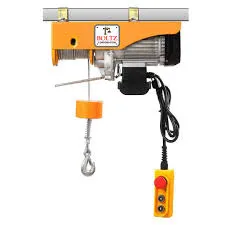


Marine Electric Winch A Vital Tool for Modern Maritime Operations
The maritime industry has experienced significant advancements over the years, particularly in the area of marine equipment. One of the most crucial tools that has emerged to facilitate various marine operations is the marine electric winch. This sophisticated piece of machinery has become indispensable for tasks ranging from mooring and towing to offshore construction and even ship maintenance. Understanding the functionality, advantages, and applications of marine electric winches is essential for anyone involved in maritime activities.
What is a Marine Electric Winch?
A marine electric winch is a device that employs electric power to wind and unwind a rope, cable, or chain. These winches are designed specifically for marine environments and come equipped with features that ensure reliability and safety in challenging conditions. The basic components of a marine electric winch include a motor, drum, gear system, and controls. Unlike their hydraulic or manual counterparts, electric winches are often easier to operate, requiring less physical effort and providing greater precision in loading and unloading operations.
Advantages of Marine Electric Winches
1. Efficiency Electric winches are known for their high efficiency. They can quickly spool and unspool lines without the need for excessive manpower, which speeds up operations significantly. This increased speed and efficiency can lead to reduced labor costs and project timelines.
2. Control and Precision Electric winches offer superior control, allowing operators to fine-tune the speed and torque. This precision is critical when handling heavy loads or executing delicate maneuvers, such as positioning equipment during offshore construction or managing the mooring of vessels in tight spaces.
3. Reduced Maintenance Compared to hydraulic systems, electric winches generally require less maintenance. They do not involve hydraulic fluids that can leak or require regular changing. The electric motor components can be monitored and serviced easily, making them more user-friendly.
4. Environmental Considerations With a growing emphasis on sustainability in the maritime sector, electric winches align with greener practices. They produce less noise pollution and emit no harmful emissions, which is particularly important in sensitive marine environments.

Applications of Marine Electric Winches
Marine electric winches are versatile and can be utilized in various applications across different maritime sectors
1. Fishing Industry These winches are used for hauling nets and traps, significantly freeing crew members from the strenuous physical demands of manual hauling, and increasing the efficiency of fishing operations.
2. Offshore Construction In offshore oil and gas projects, electric winches are essential for lifting heavy equipment and materials to platforms, ensuring safety and reliability.
3. Shipping and Logistics Electric winches are extensively used in loading and unloading cargo and securing ships at docks. They contribute significantly to the smooth logistics operations at ports.
4. Salvage Operations During salvage operations, electric winches are crucial for recovering sunken vessels and equipment. Their ability to precisely control heavy loads aids in minimizing further damage to the environment or the assets being salvaged.
Conclusion
In conclusion, the development of marine electric winches has revolutionized maritime operations by enhancing efficiency, control, and sustainability. As the maritime industry continues to evolve and embrace technological advancements, electric winches will undoubtedly play a pivotal role in shaping future practices. Whether in commercial shipping, fishing, or offshore construction, the marine electric winch stands out as an indispensable tool, enabling professionals to carry out their tasks safely and effectively. Understanding its features and applications allows stakeholders in the maritime industry to leverage this technology for improved operational success.



